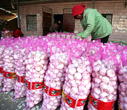Science and Health
Vaccines on horizon for AIDS, Alzheimer's, herpes
(Agencies)
Updated: 2009-11-18 14:17
The last decade brought breakthrough vaccines against pneumococcal disease and rotavirus — two of the world's top killers — meningitis, cervical cancer and more.
Better technology to create and mass produce vaccines is bringing progress in preventing tropical dengue fever and new threats like superbugs MRSA and C. difficile, even ending addiction to cocaine and nicotine. Success on some vaccines in development, particularly for Alzheimer's and AIDS, likely would bring billions a year in sales.
Just this fall and early next year, the swine flu vaccines are expected to bring their makers at least a couple billion extra dollars.
That's despite the five manufacturers for the US not being able to meet an optimistic plan to first make seasonal flu shots and then produce 120 million doses of swine flu vaccine by mid-October — an unprecedented task. But they are steadily catching up with demand.
|
||||
But a horde of biotech companies, many using multimillion-dollar government grants, already are testing state-of-the-art technology for the next pandemic.
Scientists — including some at J&J's new vaccine partner, Holland's Crucell NV — even are working to develop the holy grail: a universal flu vaccine targeting a part of the virus that doesn't change year to year.
And some future vaccines will come in patches, pills and nasal sprays, rather than painful shots.
In the last century, vaccines dramatically lengthened lifespans by stopping diseases that killed or disabled millions, from smallpox to polio.
After all those successes, many pharmaceutical companies instead focused on lucrative daily pills for chronic diseases. By the middle of this decade, only a handful were still making vaccines, which are harder to produce than chemical-based pills, making yields unpredictable.
That led to the 2004 fiasco when half the US flu shot supply was lost overnight, plus continuing periodic shortages of some kids' vaccines.
Today, five companies supply flu vaccine: GlaxoSmithKline, Switzerland's Novartis AG, Australia's CSL Biotherapies, MedImmune, part of Britain's AstraZeneca PLC, and France's Sanofi-Aventis SA.
There's been more research on flu vaccines in the last five years than in the previous 20, notes Dr. William Schaffner, Vanderbilt University's head of preventive medicine and a spokesman for the Infectious Diseases Society of America.
Now many drugmakers are rethinking vaccines.
Britain's GlaxoSmithKline is gunning to become the world's top vaccine manufacturer by revenue, unseating pioneer Merck & Co. This spring, Glaxo opened a state-of-the-art vaccine packaging plant in Marietta, Pa., west of Philadelphia, so it can expand in the US market.
Glaxo, which sold only one vaccine in the US 13 years ago, now sells 12 here — and 30 worldwide. It has 20 more in human testing, including ones for meningitis and malaria.
J&J, which previously avoided vaccines, plans to build a full vaccine portfolio, starting with universal flu and Alzheimer's vaccines, says research head Dr. Paul Stoffels.
Even Pfizer Inc.'s $68 billion acquisition of Wyeth in October was partly about getting its vaccine expertise, now being put to work against Alzheimer's. Wyeth makes the most successful vaccine ever, Prevnar, which protects children from ear infections and potentially deadly pneumonia and blood infections. Prevnar brought in $2.7 billion in 2008 sales, and with approval of an improved version pending, billions more a year are expected.
Experts call Prevnar the "game changer." It was the first vaccine to exceed $1 billion in annual sales, followed by Merck's cervical cancer shot Gardasil, with $2.3 billion in 2008 sales.
"Vaccines are now perhaps seen to be more attractive than drugs," says Dr. Stanley Plotkin, a former University of Pennsylvania professor and industry researcher who helped develop the German measles and rotavirus vaccines.
Vaccines command higher prices — roughly $375 for the three-shot Gardasil series — and so are more profitable than in the past. With only one or two makers of most vaccine types, price competition is rare in wealthy countries. Plus, they rarely face generic competition.
For flu shot makers, the risk of having to throw out millions of unused doses here come spring has plunged as US guidelines have steadily widened to include 83 percent of Americans. Use has jumped from 20 million doses in 1990 to 113 million last year.
And many companies are partnering with promising biotechs, the World Health Organization and global charities, or setting up deals with local drugmakers abroad, to inexpensively manufacture vaccines in developing and middle-tier countries that increasingly want them to prevent much-higher health care costs.
"What you had was, everybody out of the water," says analyst Steve Brozak of WBB Securities. "Now, everybody's back in the water."









